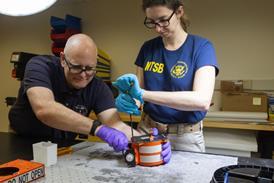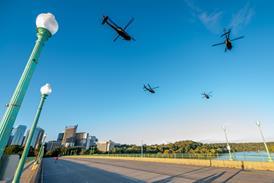Andrew Doyle/LONDON
A HYPERSONIC-aircraft concept, known as the "wave-rider", which would be capable of speeds ranging from Mach 4 to M6, is undergoing wind-tunnel tests at NASA's Langley Research Center in Virginia.
The wave-rider series, powered by air-breathing hypersonic engines, would be particularly suitable as cruise-missile carriers, high-altitude reconnaissance vehicles, and long-range strike and transport aircraft, says NASA.
A swept-wing Mach 5 configuration known as the "LoFlyte" was developed for preliminary studies under the auspices of the NASA small-business innovative-research programme.
In addition to testing in the high-speed regime, subsonic wind-tunnel tests were also required, says NASA. A 0.062-scale 2.44m-long LoFlyte model was built by Chattanooga, Tennessee-based Accurate Automation, and tested in NASA Langley's 3.66m low-speed tunnel and its 9.15 x 18.30m full-scale tunnel. The work revealed that the configuration is "aerodynamically sound through the low-speed regime", says NASA.
The tests were some of the last to be performed in Langley's full-scale tunnel, which will be officially closed on 29 September.
Meanwhile, Aero System's Engineering (ASE) and Sverdrup Technology have received a $22 million contract for preliminary design of two large, pressurised, wind-tunnels for NASA's planned $2.28 billion national wind-tunnel site, to be constructed by an industry consortium led by Boeing.
The low-speed wind tunnel will have a 6.10 x 7.32m test section, while the transonic wind-tunnel is to be built with a 3.50 x 4.58m test section. Both tunnels will be operated at pressures of up to 5 atmospheres, and will produce test conditions "...that closely approximate full-scale aircraft flight conditions", says ASE, of St Paul, Minnesota.
Source: Flight International























